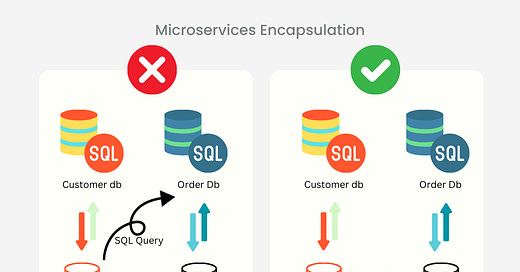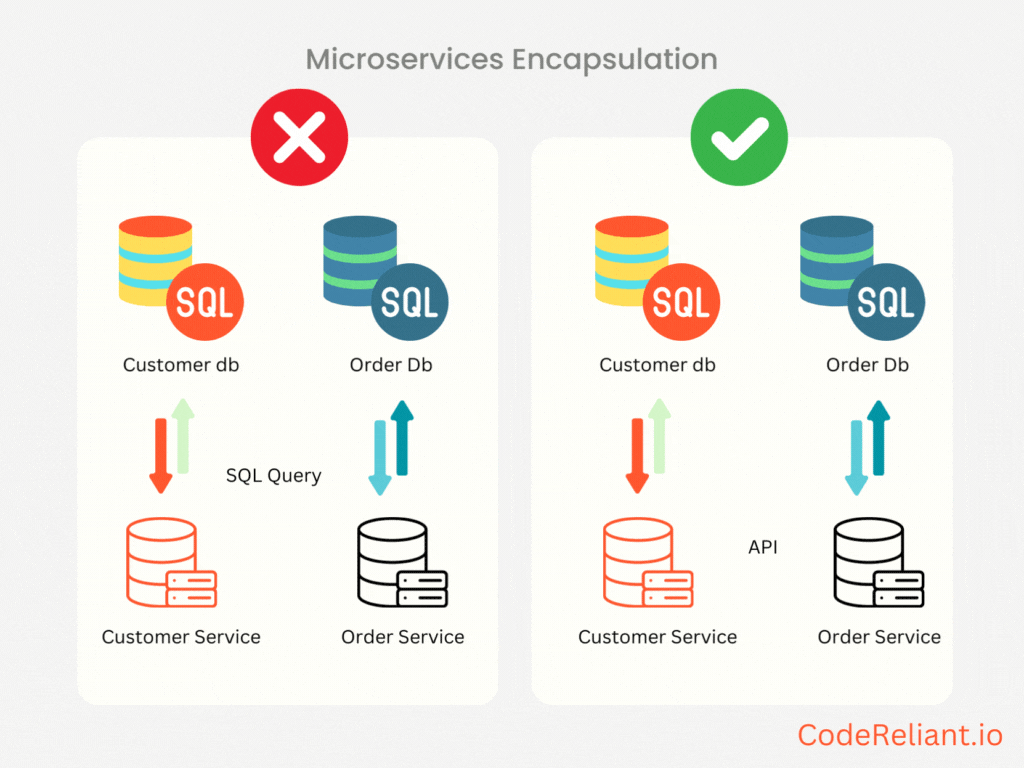Encapsulation & Reliable Software Design
In software engineering, encapsulation refers to the bundling of data and methods into a single unit, like a class in object-oriented programming. Encapsulation serves several vital purposes including information hiding, controlled access to members, and reduction of dependencies between different modules of code. These attributes make encapsulation a foundational principle for designing reliable and resilient software systems.
In this article, we’ll explore how leveraging encapsulation techniques allows creating robust software that users can depend on. We’ll look at examples of encapsulation mechanisms like access modifiers in OOP, modules in languages like Go and Rust, and closures for data encapsulation. Through information hiding, controlled access, and abstraction, software engineers can decouple components, isolate failures, and design systems that are more adaptable, scalable, and fault tolerant. By following the principle of encapsulation, engineers can write code that is more reliable from the start.
Encapsulation Limits Dependencies
One of the main ways encapsulation contributes to reliable software design is by limiting dependencies between modules, components, and services. Loose coupling is widely accepted as a best practice for building maintainable and adaptable systems. When components are highly interdependent, changes to one can cascade and cause rippling effects. Encapsulation enables loose coupling by hiding implementation details within classes, functions, or services.
For example, in object-oriented design, encapsulated classes interact only through their public interfaces or APIs. By keeping data members private and exposing access via public methods, classes reduce the risk of other code directly interacting with and manipulating the internal state. This abstraction allows the class internals to change without worrying about breaking dependents. Additionally, languages like Java allow classes to be refactored into new packages and domains without affecting consuming code.
Similarly, in microservices architecture, encapsulation enables dividing a system into independently deployable services. By owning their own data sources instead of sharing a database, services avoid risky direct coupling. As services evolve, their internal data models can change without coordination across services as long as they maintain external contracts. This facilitates agility and scalability across large, complex systems.
Through encapsulation, software engineers can design components that are insulated from the cascade of changes. Information hiding leads to modular and resilient systems where failures are contained, coupling is minimized, and reliability emerges from the composition of stable building blocks.
Encapsulation Prevents Misuse
Encapsulation not only limits dependencies but also actively prevents the misuse of code and data. By controlling access through various mechanisms, encapsulation provides assurance that components are used as intended.
In object-oriented programming, access modifiers like public and private prevent unintended interaction with the internals of a class. The public interface serves as a contract for how the class should be used. By making members private by default, classes avoid exposing implementation details that are subject to change. Getters and setters allow strictly controlling access to internal data structures. Immutable classes take this further by preventing modification of state entirely after initialization.
For services and components, encapsulation focuses on exposing only the minimal interfaces required. For example, in microservices, shared databases are avoided to prevent improper queries that conflict with the service's data model. Similarly, downstream services encapsulate logic so they are black boxes to their consumers. This forces consumers to interact with the prescribed interfaces instead of bypassing them.
Well-defined module boundaries, facades, and application programming interfaces make invalid use difficult. Input validation and security controls like authentication and authorization further restrict access. Through various encapsulation strategies, software designers can guide proper usage and prevent instability caused by misuse of code internals.
Example:
public class BankAccount {
private double balance;
public BankAccount(double openingBalance) {
balance = openingBalance;
}
// Getter method to access balance
public double getBalance() {
return balance;
}
// Setter method to deposit funds
public void deposit(double amount) {
balance += amount;
}
// Setter method to withdraw funds
public void withdraw(double amount) {
if (amount <= balance) {
balance -= amount;
} else {
System.out.println("Insufficient funds");
}
}
}In this example, the balance variable is private, preventing other classes from directly accessing it. The public getBalance() and setter methods like deposit() and withdraw() encapsulate the logic for manipulating the balance.
Making balance private prevents misuse from arbitrarily setting the balance to invalid values. The setter methods validate inputs, like ensuring the withdrawal amount is less than the current balance. This encapsulation provides a controlled interface that prevents misuse of the object's state.
The BankAccount class can be refactored without worrying about breaking dependents - as long as the public API remains the same, the private implementation details can change without consequence. This enables encapsulating complex logic behind clean and reliable interfaces.
Encapsulation Facilitates Testing
Proper encapsulation of code into testable units is a vital technique for enabling robust testing methodologies. By facilitating modular and isolated testing, encapsulation allows efficiently validating units and detecting defects early.
Encapsulated classes can be tested independently without worrying about complex interdependencies. Their public interfaces serve as contracts that mock implementations can be substituted for during unit testing. Dependency injection allows swapping real dependencies with mock objects so classes can be tested in isolation.
Likewise, encapsulated microservices simplify integration testing through their well-defined interfaces. With access to the interfaces, test cases can validate end-to-end flows by mocking collaborating services. This shifts testing left to catch issues without needing full deployment.
Within classes, encapsulated logic enables focused unit tests that verify behaviors independently. Immutability also makes testing simpler by avoiding shared mutable state across tests. Overall, encapsulation enables tests that are faster, less fragile, and maximally cover any single unit of logic.
By facilitating modular testing techniques, encapsulation allows software teams to gain confidence in the reliability of their code. Issues can be caught early through unit and integration testing of each encapsulated component before being deployed. This translates to more resilient software systems composed of well-tested building blocks.
Example:
Here is an example demonstrating how the encapsulated BankAccount class can be tested:
public class BankAccountTest {
@Test
public void testDeposit() {
BankAccount account = new BankAccount(100);
account.deposit(50);
assertEquals(150, account.getBalance());
}
@Test
public void testWithdraw() {
BankAccount account = new BankAccount(75);
account.withdraw(25);
assertEquals(50, account.getBalance());
}
@Test
public void testInvalidWithdraw() {
BankAccount account = new BankAccount(50);
account.withdraw(100);
assertEquals(50, account.getBalance());
}
}The key benefits of encapsulation for testing:
We can test deposit and withdraw in isolation without dealing with test state pollution. The
balanceis encapsulated within the account.The tests interact with the account only through the public interface (
deposit,withdraw,getBalance). This enables mocking the account class dependency later if needed.The tests don't rely on implementation details, only the class behavior and contracts. The private balance variable is not exposed.
Invalid withdrawals show that misuse is prevented by the class encapsulating validation logic.
So in summary, encapsulation enables focused, isolated, black-box testing of each class unit. We can verify the reliability of the account behavior through its public API without worrying about implementation details.
Encapsulation in Microservices
The encapsulation principle is critical for building reliable microservices architecture. By promoting loose coupling, high cohesion, and information hiding, encapsulation helps avoid tight dependencies between services.
Microservices aim to be independently deployable units that model domains or capabilities. Encapsulation enables this by ensuring services own their data models and business logic. Direct data sharing through a common database is avoided. Services interact through well-defined APIs instead of implementation details.
For example, an Order Service and Customer Service should not share a database table. The Order Service would encapsulate order data and domain logic for managing orders. The Customer Service maintains customer accounts. If orders must be retrieved for a customer, the Order Service exposes an API for that purpose.
Conclusion
Encapsulation is an essential principle for designing reliable software systems. By bundling code and data into modular units and controlling access through well-defined interfaces, encapsulation provides strong boundaries and abstraction.
Following this principle is key for managing complexity. Through composition of stable, focused units, encapsulation enables emerging reliability and resilience. While rigorous encapsulation requires deliberate design, the long-term benefits for software quality are invaluable.




